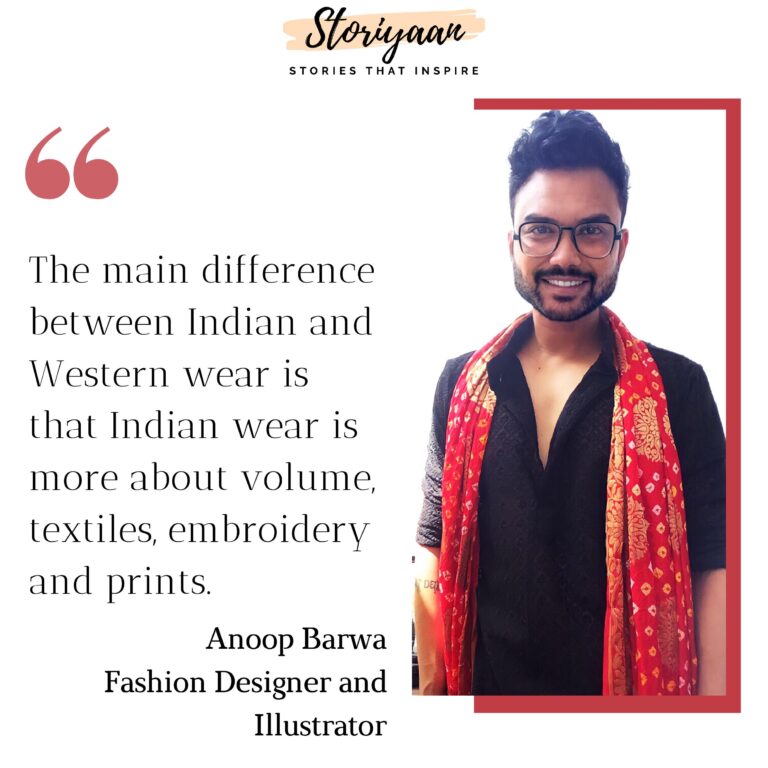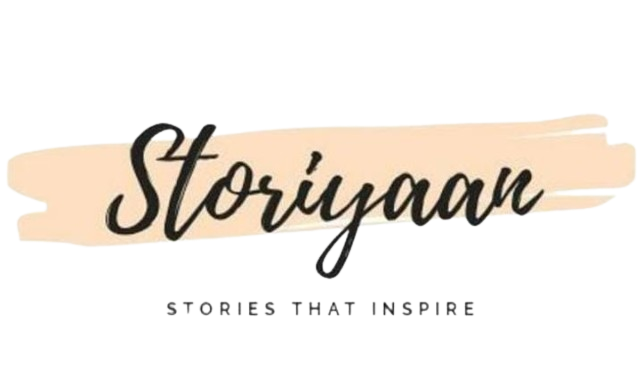Anoop Barwa, a fashion designer and illustrator from Lucknow, has introduced an elegancy in fashion by showing the combinations of Kitsch and Bohemian in his works. He plays around with Indian motifs and prints and brings about a combination of Indian and Western Styles.
Anoop has an eye for aesthetics, not only in fashion but in several fine arts. Establishing himself in a career stereotyped as a “woman’s job”, he refuses to give up, and his work speaks for itself. WA knack for writing rounds him up as a true creator of art. Learn what he has to say about his art in a conversation with Team Storiyaan.

The Style Statement with Anoop Barwa
Interview
Questions and answers
Can you start by telling us about your fascination in Fashion Designing? Where and how did it begin?
I’m always fascinated by the Indian textiles, colours and fabrics, and it motivates me to design. As a juvenile, I came through a show related to fashion where the designer was used to sketch at the end. That tempted me to draw, it became a hobby and later a profession.
You said your style is more of elegantly Kitsch and Bohemian. Can you elaborate a little about what this means to our audience?
Kitsch is an art form which is known for being trashy and unpleasant in an artistic way. Bohemian is a lifestyle which is an amalgamation of different cultures. I try to merge these two forms into a fashion which is sophisticated and pleasing to the eye.
How can you distinguish between being a fashion illustrator and a fashion designer?
Being a fashion illustrator it gives me the freedom to create a fantasy with fashion and drawing; on the contrary, being a designer, I’ve to be more practical, trendy, and fashion worthy.
Your designs always come up with a short story. It feels as if the clothes and the protagonist have a potent force binding them together, how did you come up with such a unique concept?
It is both ways, sometimes a character inspires me to design and at times it’s the character that motivates me to create a garment.
How do you choose commissions? Do you get more projects from India or abroad?
Clients choose me for my style and aesthetics. I get more work from abroad than India.
Your knack in writing is displayed well over your illustrations. The use of language is captivating and makes the illustrations even livelier. Tell us about your interest in writing.
I treasured literature in school and love reading. It helps me innovate my illustrations with a character and story.
You said that your designs are an amalgamation of Indian and Western wear. But what is the basic difference between designing both? Which do you prefer from a designer's perspective?
In my opinion, the main difference between Indian and Western wear is that Indian wear is more about volume, textiles, embroidery and prints. At the same time, Western wear is about fabrics, textures and accentuating the shape of the body. I like to combine Indian fabric with a Western silhouette. Being an Indian, I’m more inclined towards Indian wear.
How has working with various clients helped you modify your skills? Can you tell us about a few client cases which challenged your skills?
I’ve done commissions for fashion students to some renowned brands, and one thing I learnt the most is to be patient. The other skill I developed over time was to make my illustrations as detailed and lively as possible. I come through clients who demand me for copious details which are almost impossible to draw with human capabilities but somehow I’m able to pass through the challenges and develop ways to do things.
You call yourself a connoisseur. Can you share more about your interest in various fine arts and cuisines other than fashion? Would you call yourself a food stylist?
I have got a keen interest in all kind of art and innovation, but lately, I advanced interest in interiors. I do love food and international cuisines, but no, I won’t call myself a food stylist.
One of your projects titled "Ugly duckling" is inspired by the story of the Ugly duckling. Can you tell us a little bit more about this project? What was it about the story that inspired you?
I must say you have dug deep into my work. Well, yes, somewhere, the illustration was inspired by the story and my real-life experiences. But I came through my worries and negativity and cherished as a swan. The message I wanted to convey by design was to know one’s capabilities, everyone is talented. They just have to come out loud and strong.
Have you ever faced sexism in your career? Is fashion designing thought of to be a "woman's" career?
Yes, a lot, actually the society is divided in a way where there are do’s, and dont’s for men and women. But my parents are very supportive and appreciate me for the work I do. Here the story of ugly duckling comes alive.
Even though your illustrations are only sketches, they seem to have attitude and poise. Is this a conscious decision? How do you decide which pose will suit which design?
Attitude and poise in the postures play a vital role in fashion illustration. It enhances the garment. My decision about a pose depends on the silhouette, flow and design of the attire.
What was the inspiration behind the "Enchanted Veil"? Can you tell our readers a little bit about it?
The inspiration behind the “Enchanted Veil” was the exhaustion which we all are going through in this pandemic. I tried to bring some positivity from the depression and anxiety we are experiencing. I wanted to deliver a message that struggle never goes in vain; there’s always light on the other side of the tunnel.
Quick 5
1. Drawing on paper or a computer? – Paper
2. A fashion trend you don’t understand– Plunge neckline
3. Fashion Capital, according to you is– New York
4. What would you rather-Author a book or Walk the Ramp? – Author a book with fashion and illustration
5. If you had to describe your artwork into three adjectives, what would they be?- Traditional, innovative and surreal.

